Comparative Analysis: Government and Innovation in Singapore/Thailand
VerifiedAdded on 2021/08/16
|16
|6707
|187
Report
AI Summary
This research paper, published in the Int. J. Technology, Policy and Management, examines the government's role in fostering innovation, specifically within the framework of Porter's Diamond Model. The study employs a comparative case study approach, analyzing the innovation policies of Singapore and Thailand, with a particular focus on tax policies and R&D tax incentives. The author investigates how these policies support technology commercialization and high-tech industries. The research utilizes both primary data from interviews with government agencies and companies, and secondary data to validate findings. The paper reviews the theoretical framework of R&D investments, government policies, and Porter's Diamond Model, highlighting the importance of government intervention in building national innovative capacity and promoting cluster development. The findings offer policy lessons regarding the use of tax policies as tools for fostering technological innovation, providing insights for policymakers and readers interested in understanding the relationship between government roles, innovation politics, and innovation system development. The study concludes by drawing implications for supporting high-tech entrepreneurship in developing economies, and by filling a gap in existing research on innovation politics and government policies.
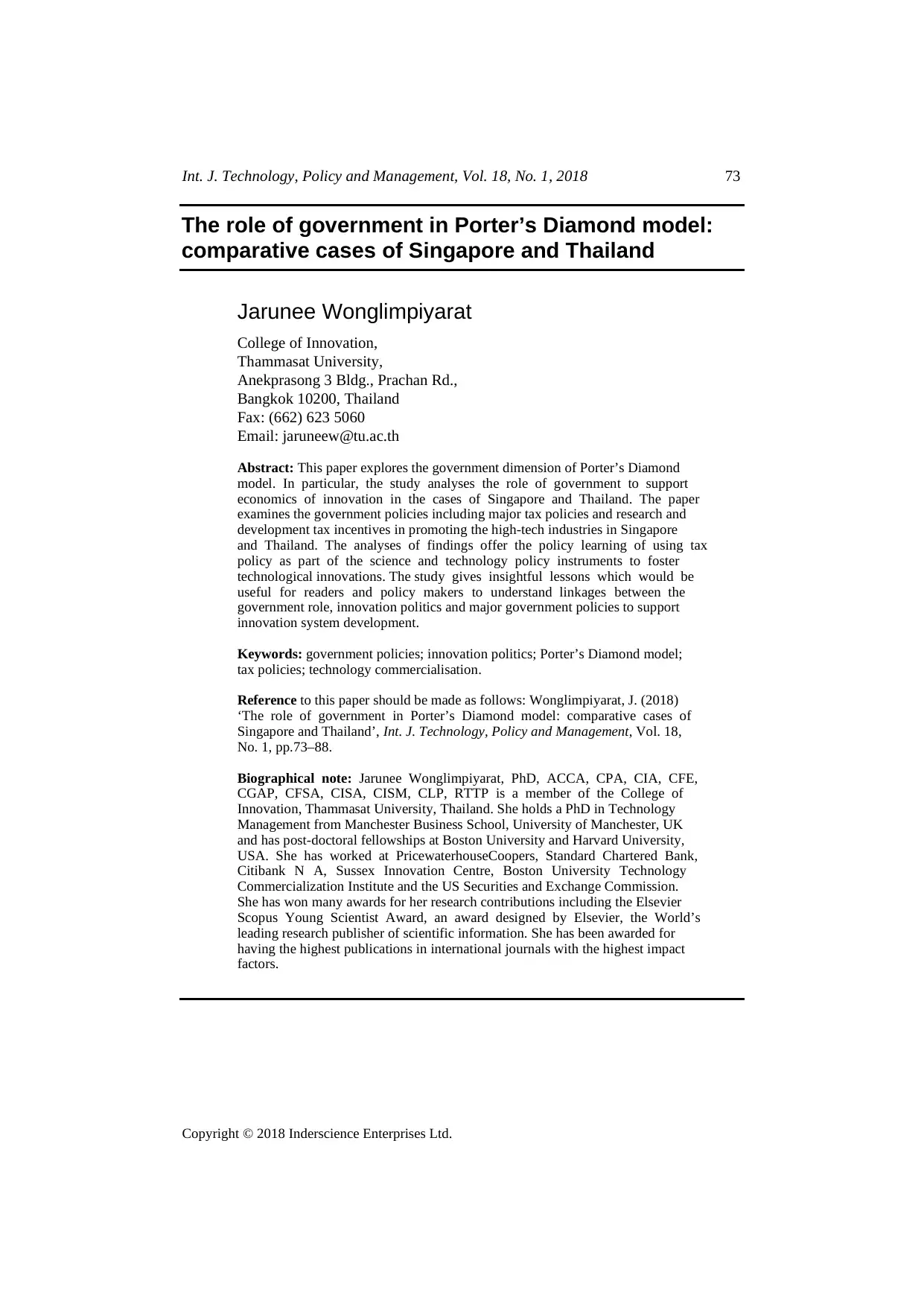
Int. J. Technology, Policy and Management, Vol. 18, No. 1, 2018 73
Copyright © 2018 Inderscience Enterprises Ltd.
The role of government in Porter’s Diamond model:
comparative cases of Singapore and Thailand
Jarunee Wonglimpiyarat
College of Innovation,
Thammasat University,
Anekprasong 3 Bldg., Prachan Rd.,
Bangkok 10200, Thailand
Fax: (662) 623 5060
Email: jaruneew@tu.ac.th
Abstract: This paper explores the government dimension of Porter’s Diamond
model. In particular, the study analyses the role of government to support
economics of innovation in the cases of Singapore and Thailand. The paper
examines the government policies including major tax policies and research and
development tax incentives in promoting the high-tech industries in Singapore
and Thailand. The analyses of findings offer the policy learning of using tax
policy as part of the science and technology policy instruments to foster
technological innovations. The study gives insightful lessons which would be
useful for readers and policy makers to understand linkages between the
government role, innovation politics and major government policies to support
innovation system development.
Keywords: government policies; innovation politics; Porter’s Diamond model;
tax policies; technology commercialisation.
Reference to this paper should be made as follows: Wonglimpiyarat, J. (2018)
‘The role of government in Porter’s Diamond model: comparative cases of
Singapore and Thailand’, Int. J. Technology, Policy and Management, Vol. 18,
No. 1, pp.73–88.
Biographical note: Jarunee Wonglimpiyarat, PhD, ACCA, CPA, CIA, CFE,
CGAP, CFSA, CISA, CISM, CLP, RTTP is a member of the College of
Innovation, Thammasat University, Thailand. She holds a PhD in Technology
Management from Manchester Business School, University of Manchester, UK
and has post-doctoral fellowships at Boston University and Harvard University,
USA. She has worked at PricewaterhouseCoopers, Standard Chartered Bank,
Citibank N A, Sussex Innovation Centre, Boston University Technology
Commercialization Institute and the US Securities and Exchange Commission.
She has won many awards for her research contributions including the Elsevier
Scopus Young Scientist Award, an award designed by Elsevier, the World’s
leading research publisher of scientific information. She has been awarded for
having the highest publications in international journals with the highest impact
factors.
Copyright © 2018 Inderscience Enterprises Ltd.
The role of government in Porter’s Diamond model:
comparative cases of Singapore and Thailand
Jarunee Wonglimpiyarat
College of Innovation,
Thammasat University,
Anekprasong 3 Bldg., Prachan Rd.,
Bangkok 10200, Thailand
Fax: (662) 623 5060
Email: jaruneew@tu.ac.th
Abstract: This paper explores the government dimension of Porter’s Diamond
model. In particular, the study analyses the role of government to support
economics of innovation in the cases of Singapore and Thailand. The paper
examines the government policies including major tax policies and research and
development tax incentives in promoting the high-tech industries in Singapore
and Thailand. The analyses of findings offer the policy learning of using tax
policy as part of the science and technology policy instruments to foster
technological innovations. The study gives insightful lessons which would be
useful for readers and policy makers to understand linkages between the
government role, innovation politics and major government policies to support
innovation system development.
Keywords: government policies; innovation politics; Porter’s Diamond model;
tax policies; technology commercialisation.
Reference to this paper should be made as follows: Wonglimpiyarat, J. (2018)
‘The role of government in Porter’s Diamond model: comparative cases of
Singapore and Thailand’, Int. J. Technology, Policy and Management, Vol. 18,
No. 1, pp.73–88.
Biographical note: Jarunee Wonglimpiyarat, PhD, ACCA, CPA, CIA, CFE,
CGAP, CFSA, CISA, CISM, CLP, RTTP is a member of the College of
Innovation, Thammasat University, Thailand. She holds a PhD in Technology
Management from Manchester Business School, University of Manchester, UK
and has post-doctoral fellowships at Boston University and Harvard University,
USA. She has worked at PricewaterhouseCoopers, Standard Chartered Bank,
Citibank N A, Sussex Innovation Centre, Boston University Technology
Commercialization Institute and the US Securities and Exchange Commission.
She has won many awards for her research contributions including the Elsevier
Scopus Young Scientist Award, an award designed by Elsevier, the World’s
leading research publisher of scientific information. She has been awarded for
having the highest publications in international journals with the highest impact
factors.
Paraphrase This Document
Need a fresh take? Get an instant paraphrase of this document with our AI Paraphraser
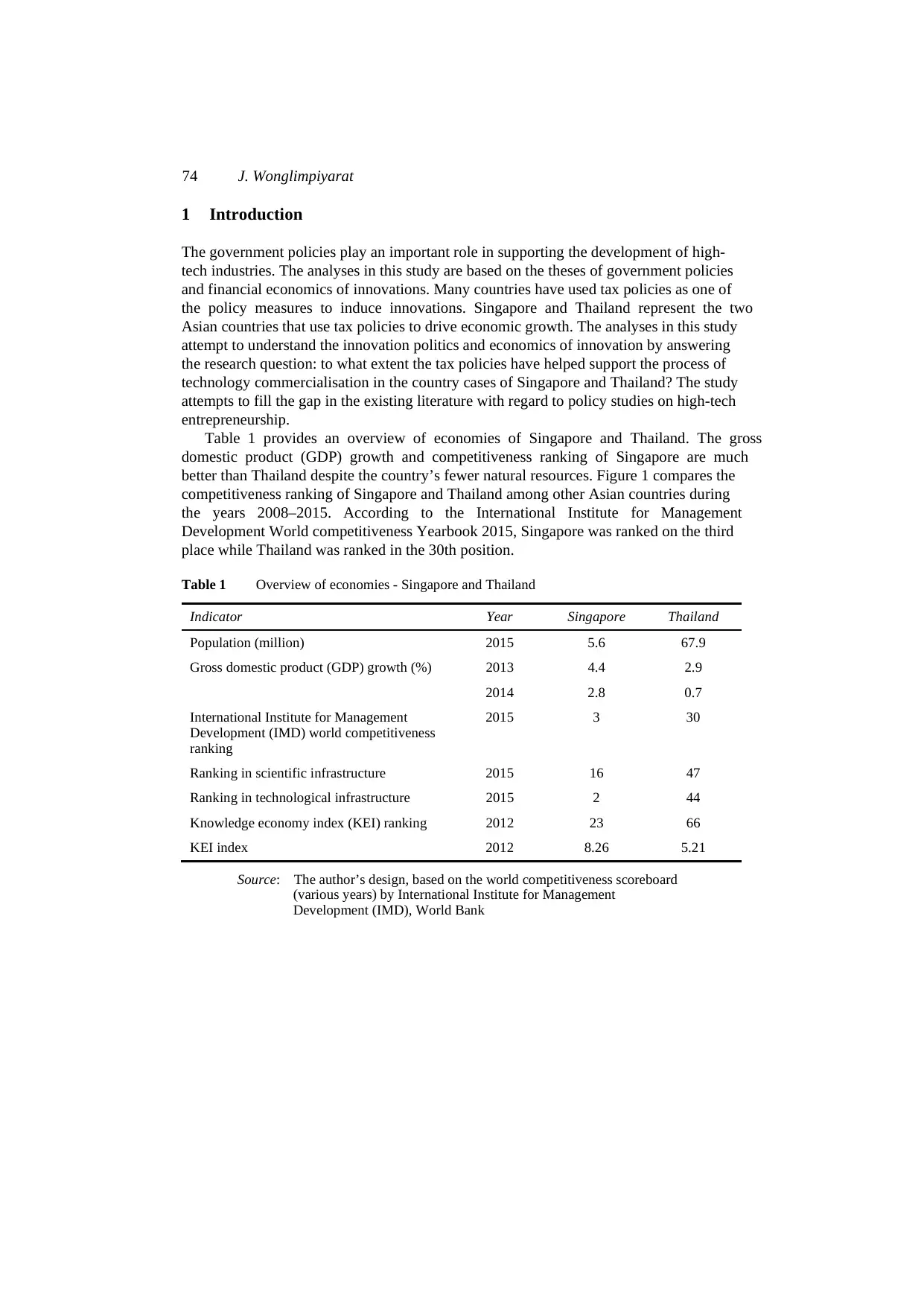
74 J. Wonglimpiyarat
1 Introduction
The government policies play an important role in supporting the development of high-
tech industries. The analyses in this study are based on the theses of government policies
and financial economics of innovations. Many countries have used tax policies as one of
the policy measures to induce innovations. Singapore and Thailand represent the two
Asian countries that use tax policies to drive economic growth. The analyses in this study
attempt to understand the innovation politics and economics of innovation by answering
the research question: to what extent the tax policies have helped support the process of
technology commercialisation in the country cases of Singapore and Thailand? The study
attempts to fill the gap in the existing literature with regard to policy studies on high-tech
entrepreneurship.
Table 1 provides an overview of economies of Singapore and Thailand. The gross
domestic product (GDP) growth and competitiveness ranking of Singapore are much
better than Thailand despite the country’s fewer natural resources. Figure 1 compares the
competitiveness ranking of Singapore and Thailand among other Asian countries during
the years 2008–2015. According to the International Institute for Management
Development World competitiveness Yearbook 2015, Singapore was ranked on the third
place while Thailand was ranked in the 30th position.
Table 1 Overview of economies - Singapore and Thailand
Indicator Year Singapore Thailand
Population (million) 2015 5.6 67.9
Gross domestic product (GDP) growth (%) 2013 4.4 2.9
2014 2.8 0.7
International Institute for Management
Development (IMD) world competitiveness
ranking
2015 3 30
Ranking in scientific infrastructure 2015 16 47
Ranking in technological infrastructure 2015 2 44
Knowledge economy index (KEI) ranking 2012 23 66
KEI index 2012 8.26 5.21
Source: The author’s design, based on the world competitiveness scoreboard
(various years) by International Institute for Management
Development (IMD), World Bank
1 Introduction
The government policies play an important role in supporting the development of high-
tech industries. The analyses in this study are based on the theses of government policies
and financial economics of innovations. Many countries have used tax policies as one of
the policy measures to induce innovations. Singapore and Thailand represent the two
Asian countries that use tax policies to drive economic growth. The analyses in this study
attempt to understand the innovation politics and economics of innovation by answering
the research question: to what extent the tax policies have helped support the process of
technology commercialisation in the country cases of Singapore and Thailand? The study
attempts to fill the gap in the existing literature with regard to policy studies on high-tech
entrepreneurship.
Table 1 provides an overview of economies of Singapore and Thailand. The gross
domestic product (GDP) growth and competitiveness ranking of Singapore are much
better than Thailand despite the country’s fewer natural resources. Figure 1 compares the
competitiveness ranking of Singapore and Thailand among other Asian countries during
the years 2008–2015. According to the International Institute for Management
Development World competitiveness Yearbook 2015, Singapore was ranked on the third
place while Thailand was ranked in the 30th position.
Table 1 Overview of economies - Singapore and Thailand
Indicator Year Singapore Thailand
Population (million) 2015 5.6 67.9
Gross domestic product (GDP) growth (%) 2013 4.4 2.9
2014 2.8 0.7
International Institute for Management
Development (IMD) world competitiveness
ranking
2015 3 30
Ranking in scientific infrastructure 2015 16 47
Ranking in technological infrastructure 2015 2 44
Knowledge economy index (KEI) ranking 2012 23 66
KEI index 2012 8.26 5.21
Source: The author’s design, based on the world competitiveness scoreboard
(various years) by International Institute for Management
Development (IMD), World Bank
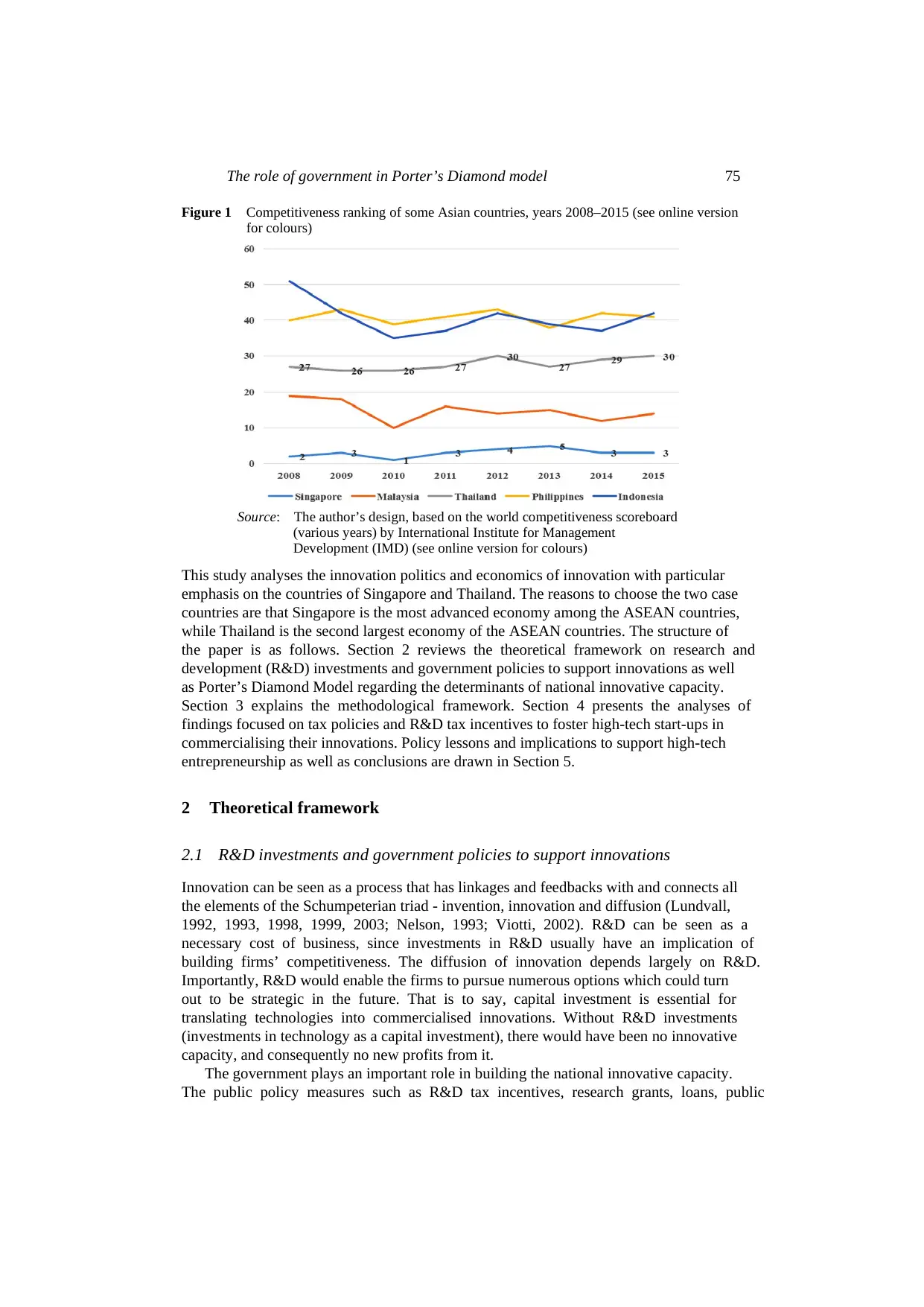
The role of government in Porter’s Diamond model 75
Figure 1 Competitiveness ranking of some Asian countries, years 2008–2015 (see online version
for colours)
Source: The author’s design, based on the world competitiveness scoreboard
(various years) by International Institute for Management
Development (IMD) (see online version for colours)
This study analyses the innovation politics and economics of innovation with particular
emphasis on the countries of Singapore and Thailand. The reasons to choose the two case
countries are that Singapore is the most advanced economy among the ASEAN countries,
while Thailand is the second largest economy of the ASEAN countries. The structure of
the paper is as follows. Section 2 reviews the theoretical framework on research and
development (R&D) investments and government policies to support innovations as well
as Porter’s Diamond Model regarding the determinants of national innovative capacity.
Section 3 explains the methodological framework. Section 4 presents the analyses of
findings focused on tax policies and R&D tax incentives to foster high-tech start-ups in
commercialising their innovations. Policy lessons and implications to support high-tech
entrepreneurship as well as conclusions are drawn in Section 5.
2 Theoretical framework
2.1 R&D investments and government policies to support innovations
Innovation can be seen as a process that has linkages and feedbacks with and connects all
the elements of the Schumpeterian triad - invention, innovation and diffusion (Lundvall,
1992, 1993, 1998, 1999, 2003; Nelson, 1993; Viotti, 2002). R&D can be seen as a
necessary cost of business, since investments in R&D usually have an implication of
building firms’ competitiveness. The diffusion of innovation depends largely on R&D.
Importantly, R&D would enable the firms to pursue numerous options which could turn
out to be strategic in the future. That is to say, capital investment is essential for
translating technologies into commercialised innovations. Without R&D investments
(investments in technology as a capital investment), there would have been no innovative
capacity, and consequently no new profits from it.
The government plays an important role in building the national innovative capacity.
The public policy measures such as R&D tax incentives, research grants, loans, public
Figure 1 Competitiveness ranking of some Asian countries, years 2008–2015 (see online version
for colours)
Source: The author’s design, based on the world competitiveness scoreboard
(various years) by International Institute for Management
Development (IMD) (see online version for colours)
This study analyses the innovation politics and economics of innovation with particular
emphasis on the countries of Singapore and Thailand. The reasons to choose the two case
countries are that Singapore is the most advanced economy among the ASEAN countries,
while Thailand is the second largest economy of the ASEAN countries. The structure of
the paper is as follows. Section 2 reviews the theoretical framework on research and
development (R&D) investments and government policies to support innovations as well
as Porter’s Diamond Model regarding the determinants of national innovative capacity.
Section 3 explains the methodological framework. Section 4 presents the analyses of
findings focused on tax policies and R&D tax incentives to foster high-tech start-ups in
commercialising their innovations. Policy lessons and implications to support high-tech
entrepreneurship as well as conclusions are drawn in Section 5.
2 Theoretical framework
2.1 R&D investments and government policies to support innovations
Innovation can be seen as a process that has linkages and feedbacks with and connects all
the elements of the Schumpeterian triad - invention, innovation and diffusion (Lundvall,
1992, 1993, 1998, 1999, 2003; Nelson, 1993; Viotti, 2002). R&D can be seen as a
necessary cost of business, since investments in R&D usually have an implication of
building firms’ competitiveness. The diffusion of innovation depends largely on R&D.
Importantly, R&D would enable the firms to pursue numerous options which could turn
out to be strategic in the future. That is to say, capital investment is essential for
translating technologies into commercialised innovations. Without R&D investments
(investments in technology as a capital investment), there would have been no innovative
capacity, and consequently no new profits from it.
The government plays an important role in building the national innovative capacity.
The public policy measures such as R&D tax incentives, research grants, loans, public
⊘ This is a preview!⊘
Do you want full access?
Subscribe today to unlock all pages.

Trusted by 1+ million students worldwide
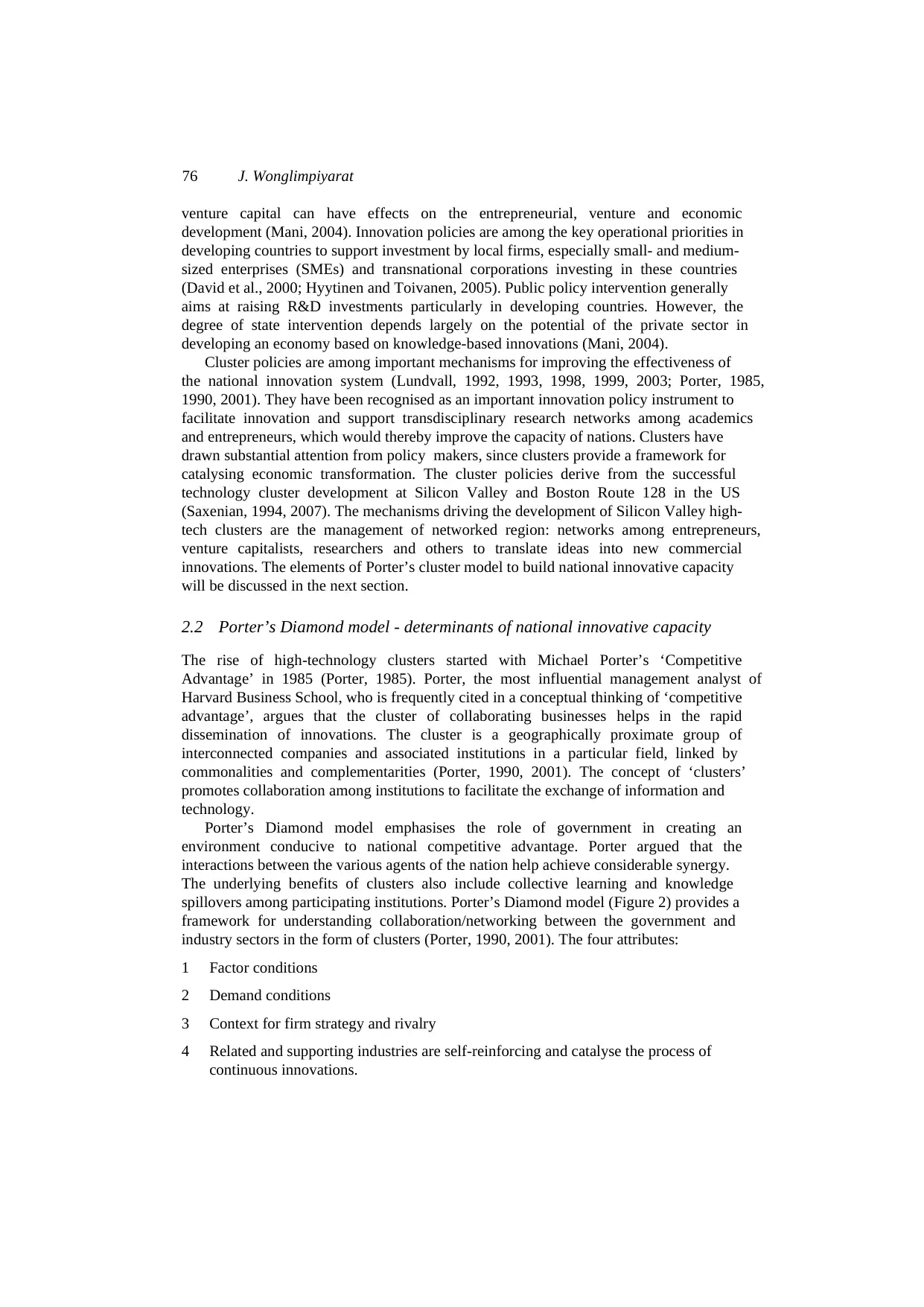
76 J. Wonglimpiyarat
venture capital can have effects on the entrepreneurial, venture and economic
development (Mani, 2004). Innovation policies are among the key operational priorities in
developing countries to support investment by local firms, especially small- and medium-
sized enterprises (SMEs) and transnational corporations investing in these countries
(David et al., 2000; Hyytinen and Toivanen, 2005). Public policy intervention generally
aims at raising R&D investments particularly in developing countries. However, the
degree of state intervention depends largely on the potential of the private sector in
developing an economy based on knowledge-based innovations (Mani, 2004).
Cluster policies are among important mechanisms for improving the effectiveness of
the national innovation system (Lundvall, 1992, 1993, 1998, 1999, 2003; Porter, 1985,
1990, 2001). They have been recognised as an important innovation policy instrument to
facilitate innovation and support transdisciplinary research networks among academics
and entrepreneurs, which would thereby improve the capacity of nations. Clusters have
drawn substantial attention from policy makers, since clusters provide a framework for
catalysing economic transformation. The cluster policies derive from the successful
technology cluster development at Silicon Valley and Boston Route 128 in the US
(Saxenian, 1994, 2007). The mechanisms driving the development of Silicon Valley high-
tech clusters are the management of networked region: networks among entrepreneurs,
venture capitalists, researchers and others to translate ideas into new commercial
innovations. The elements of Porter’s cluster model to build national innovative capacity
will be discussed in the next section.
2.2 Porter’s Diamond model - determinants of national innovative capacity
The rise of high-technology clusters started with Michael Porter’s ‘Competitive
Advantage’ in 1985 (Porter, 1985). Porter, the most influential management analyst of
Harvard Business School, who is frequently cited in a conceptual thinking of ‘competitive
advantage’, argues that the cluster of collaborating businesses helps in the rapid
dissemination of innovations. The cluster is a geographically proximate group of
interconnected companies and associated institutions in a particular field, linked by
commonalities and complementarities (Porter, 1990, 2001). The concept of ‘clusters’
promotes collaboration among institutions to facilitate the exchange of information and
technology.
Porter’s Diamond model emphasises the role of government in creating an
environment conducive to national competitive advantage. Porter argued that the
interactions between the various agents of the nation help achieve considerable synergy.
The underlying benefits of clusters also include collective learning and knowledge
spillovers among participating institutions. Porter’s Diamond model (Figure 2) provides a
framework for understanding collaboration/networking between the government and
industry sectors in the form of clusters (Porter, 1990, 2001). The four attributes:
1 Factor conditions
2 Demand conditions
3 Context for firm strategy and rivalry
4 Related and supporting industries are self-reinforcing and catalyse the process of
continuous innovations.
venture capital can have effects on the entrepreneurial, venture and economic
development (Mani, 2004). Innovation policies are among the key operational priorities in
developing countries to support investment by local firms, especially small- and medium-
sized enterprises (SMEs) and transnational corporations investing in these countries
(David et al., 2000; Hyytinen and Toivanen, 2005). Public policy intervention generally
aims at raising R&D investments particularly in developing countries. However, the
degree of state intervention depends largely on the potential of the private sector in
developing an economy based on knowledge-based innovations (Mani, 2004).
Cluster policies are among important mechanisms for improving the effectiveness of
the national innovation system (Lundvall, 1992, 1993, 1998, 1999, 2003; Porter, 1985,
1990, 2001). They have been recognised as an important innovation policy instrument to
facilitate innovation and support transdisciplinary research networks among academics
and entrepreneurs, which would thereby improve the capacity of nations. Clusters have
drawn substantial attention from policy makers, since clusters provide a framework for
catalysing economic transformation. The cluster policies derive from the successful
technology cluster development at Silicon Valley and Boston Route 128 in the US
(Saxenian, 1994, 2007). The mechanisms driving the development of Silicon Valley high-
tech clusters are the management of networked region: networks among entrepreneurs,
venture capitalists, researchers and others to translate ideas into new commercial
innovations. The elements of Porter’s cluster model to build national innovative capacity
will be discussed in the next section.
2.2 Porter’s Diamond model - determinants of national innovative capacity
The rise of high-technology clusters started with Michael Porter’s ‘Competitive
Advantage’ in 1985 (Porter, 1985). Porter, the most influential management analyst of
Harvard Business School, who is frequently cited in a conceptual thinking of ‘competitive
advantage’, argues that the cluster of collaborating businesses helps in the rapid
dissemination of innovations. The cluster is a geographically proximate group of
interconnected companies and associated institutions in a particular field, linked by
commonalities and complementarities (Porter, 1990, 2001). The concept of ‘clusters’
promotes collaboration among institutions to facilitate the exchange of information and
technology.
Porter’s Diamond model emphasises the role of government in creating an
environment conducive to national competitive advantage. Porter argued that the
interactions between the various agents of the nation help achieve considerable synergy.
The underlying benefits of clusters also include collective learning and knowledge
spillovers among participating institutions. Porter’s Diamond model (Figure 2) provides a
framework for understanding collaboration/networking between the government and
industry sectors in the form of clusters (Porter, 1990, 2001). The four attributes:
1 Factor conditions
2 Demand conditions
3 Context for firm strategy and rivalry
4 Related and supporting industries are self-reinforcing and catalyse the process of
continuous innovations.
Paraphrase This Document
Need a fresh take? Get an instant paraphrase of this document with our AI Paraphraser
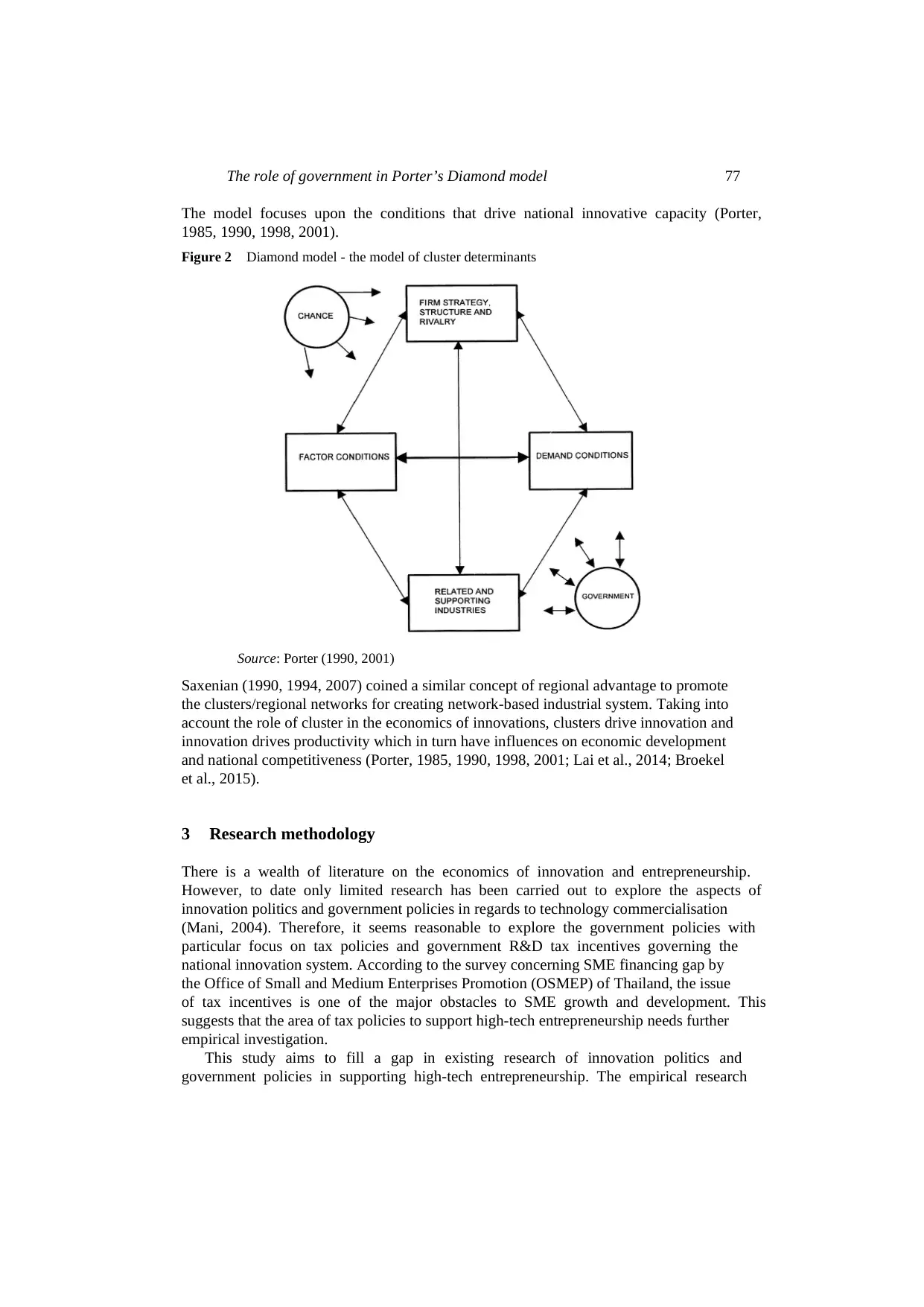
The role of government in Porter’s Diamond model 77
The model focuses upon the conditions that drive national innovative capacity (Porter,
1985, 1990, 1998, 2001).
Figure 2 Diamond model - the model of cluster determinants
Source: Porter (1990, 2001)
Saxenian (1990, 1994, 2007) coined a similar concept of regional advantage to promote
the clusters/regional networks for creating network-based industrial system. Taking into
account the role of cluster in the economics of innovations, clusters drive innovation and
innovation drives productivity which in turn have influences on economic development
and national competitiveness (Porter, 1985, 1990, 1998, 2001; Lai et al., 2014; Broekel
et al., 2015).
3 Research methodology
There is a wealth of literature on the economics of innovation and entrepreneurship.
However, to date only limited research has been carried out to explore the aspects of
innovation politics and government policies in regards to technology commercialisation
(Mani, 2004). Therefore, it seems reasonable to explore the government policies with
particular focus on tax policies and government R&D tax incentives governing the
national innovation system. According to the survey concerning SME financing gap by
the Office of Small and Medium Enterprises Promotion (OSMEP) of Thailand, the issue
of tax incentives is one of the major obstacles to SME growth and development. This
suggests that the area of tax policies to support high-tech entrepreneurship needs further
empirical investigation.
This study aims to fill a gap in existing research of innovation politics and
government policies in supporting high-tech entrepreneurship. The empirical research
The model focuses upon the conditions that drive national innovative capacity (Porter,
1985, 1990, 1998, 2001).
Figure 2 Diamond model - the model of cluster determinants
Source: Porter (1990, 2001)
Saxenian (1990, 1994, 2007) coined a similar concept of regional advantage to promote
the clusters/regional networks for creating network-based industrial system. Taking into
account the role of cluster in the economics of innovations, clusters drive innovation and
innovation drives productivity which in turn have influences on economic development
and national competitiveness (Porter, 1985, 1990, 1998, 2001; Lai et al., 2014; Broekel
et al., 2015).
3 Research methodology
There is a wealth of literature on the economics of innovation and entrepreneurship.
However, to date only limited research has been carried out to explore the aspects of
innovation politics and government policies in regards to technology commercialisation
(Mani, 2004). Therefore, it seems reasonable to explore the government policies with
particular focus on tax policies and government R&D tax incentives governing the
national innovation system. According to the survey concerning SME financing gap by
the Office of Small and Medium Enterprises Promotion (OSMEP) of Thailand, the issue
of tax incentives is one of the major obstacles to SME growth and development. This
suggests that the area of tax policies to support high-tech entrepreneurship needs further
empirical investigation.
This study aims to fill a gap in existing research of innovation politics and
government policies in supporting high-tech entrepreneurship. The empirical research
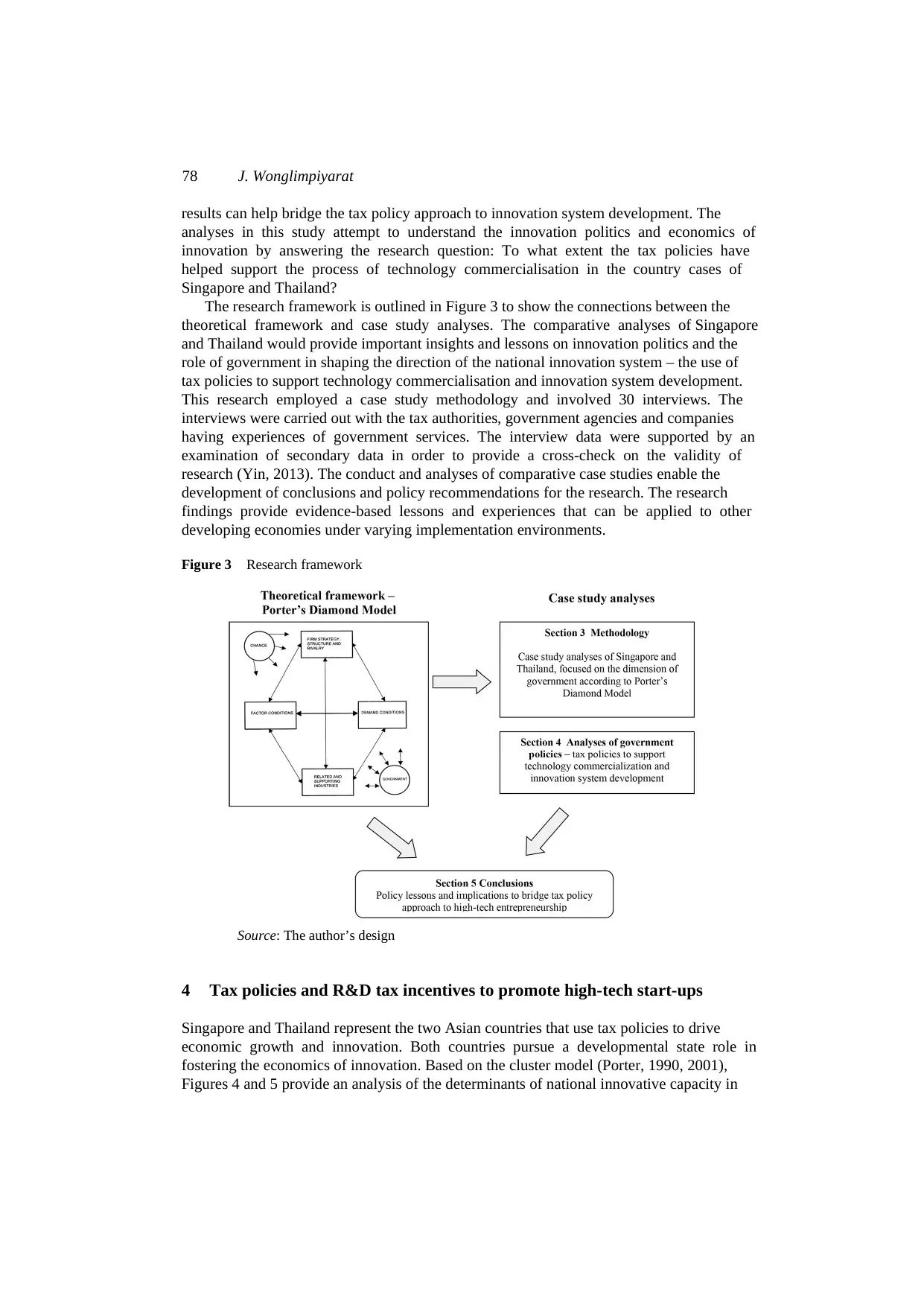
78 J. Wonglimpiyarat
results can help bridge the tax policy approach to innovation system development. The
analyses in this study attempt to understand the innovation politics and economics of
innovation by answering the research question: To what extent the tax policies have
helped support the process of technology commercialisation in the country cases of
Singapore and Thailand?
The research framework is outlined in Figure 3 to show the connections between the
theoretical framework and case study analyses. The comparative analyses of Singapore
and Thailand would provide important insights and lessons on innovation politics and the
role of government in shaping the direction of the national innovation system – the use of
tax policies to support technology commercialisation and innovation system development.
This research employed a case study methodology and involved 30 interviews. The
interviews were carried out with the tax authorities, government agencies and companies
having experiences of government services. The interview data were supported by an
examination of secondary data in order to provide a cross-check on the validity of
research (Yin, 2013). The conduct and analyses of comparative case studies enable the
development of conclusions and policy recommendations for the research. The research
findings provide evidence-based lessons and experiences that can be applied to other
developing economies under varying implementation environments.
Figure 3 Research framework
Source: The author’s design
4 Tax policies and R&D tax incentives to promote high-tech start-ups
Singapore and Thailand represent the two Asian countries that use tax policies to drive
economic growth and innovation. Both countries pursue a developmental state role in
fostering the economics of innovation. Based on the cluster model (Porter, 1990, 2001),
Figures 4 and 5 provide an analysis of the determinants of national innovative capacity in
results can help bridge the tax policy approach to innovation system development. The
analyses in this study attempt to understand the innovation politics and economics of
innovation by answering the research question: To what extent the tax policies have
helped support the process of technology commercialisation in the country cases of
Singapore and Thailand?
The research framework is outlined in Figure 3 to show the connections between the
theoretical framework and case study analyses. The comparative analyses of Singapore
and Thailand would provide important insights and lessons on innovation politics and the
role of government in shaping the direction of the national innovation system – the use of
tax policies to support technology commercialisation and innovation system development.
This research employed a case study methodology and involved 30 interviews. The
interviews were carried out with the tax authorities, government agencies and companies
having experiences of government services. The interview data were supported by an
examination of secondary data in order to provide a cross-check on the validity of
research (Yin, 2013). The conduct and analyses of comparative case studies enable the
development of conclusions and policy recommendations for the research. The research
findings provide evidence-based lessons and experiences that can be applied to other
developing economies under varying implementation environments.
Figure 3 Research framework
Source: The author’s design
4 Tax policies and R&D tax incentives to promote high-tech start-ups
Singapore and Thailand represent the two Asian countries that use tax policies to drive
economic growth and innovation. Both countries pursue a developmental state role in
fostering the economics of innovation. Based on the cluster model (Porter, 1990, 2001),
Figures 4 and 5 provide an analysis of the determinants of national innovative capacity in
⊘ This is a preview!⊘
Do you want full access?
Subscribe today to unlock all pages.

Trusted by 1+ million students worldwide
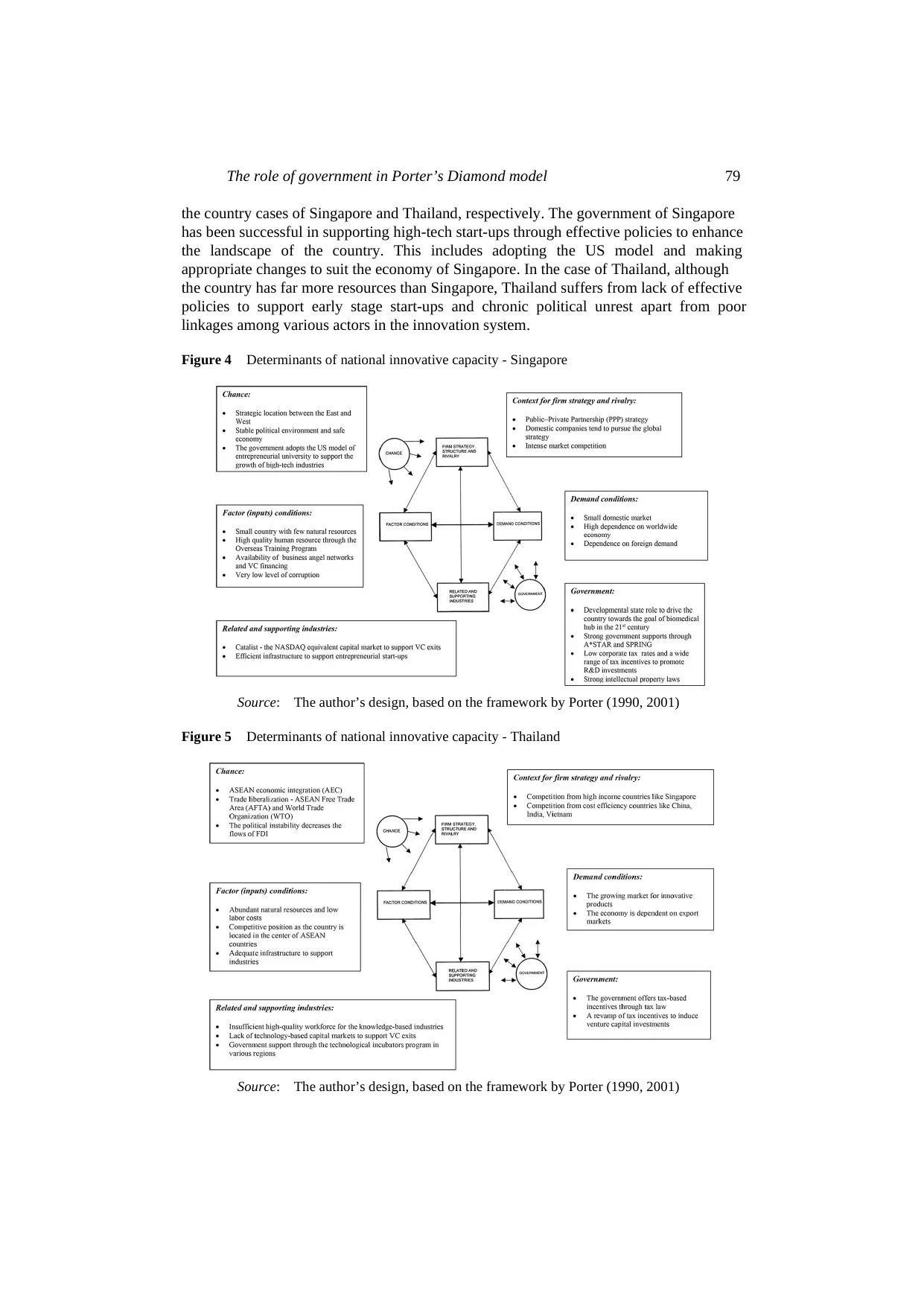
The role of government in Porter’s Diamond model 79
the country cases of Singapore and Thailand, respectively. The government of Singapore
has been successful in supporting high-tech start-ups through effective policies to enhance
the landscape of the country. This includes adopting the US model and making
appropriate changes to suit the economy of Singapore. In the case of Thailand, although
the country has far more resources than Singapore, Thailand suffers from lack of effective
policies to support early stage start-ups and chronic political unrest apart from poor
linkages among various actors in the innovation system.
Figure 4 Determinants of national innovative capacity - Singapore
Source: The author’s design, based on the framework by Porter (1990, 2001)
Figure 5 Determinants of national innovative capacity - Thailand
Source: The author’s design, based on the framework by Porter (1990, 2001)
the country cases of Singapore and Thailand, respectively. The government of Singapore
has been successful in supporting high-tech start-ups through effective policies to enhance
the landscape of the country. This includes adopting the US model and making
appropriate changes to suit the economy of Singapore. In the case of Thailand, although
the country has far more resources than Singapore, Thailand suffers from lack of effective
policies to support early stage start-ups and chronic political unrest apart from poor
linkages among various actors in the innovation system.
Figure 4 Determinants of national innovative capacity - Singapore
Source: The author’s design, based on the framework by Porter (1990, 2001)
Figure 5 Determinants of national innovative capacity - Thailand
Source: The author’s design, based on the framework by Porter (1990, 2001)
Paraphrase This Document
Need a fresh take? Get an instant paraphrase of this document with our AI Paraphraser
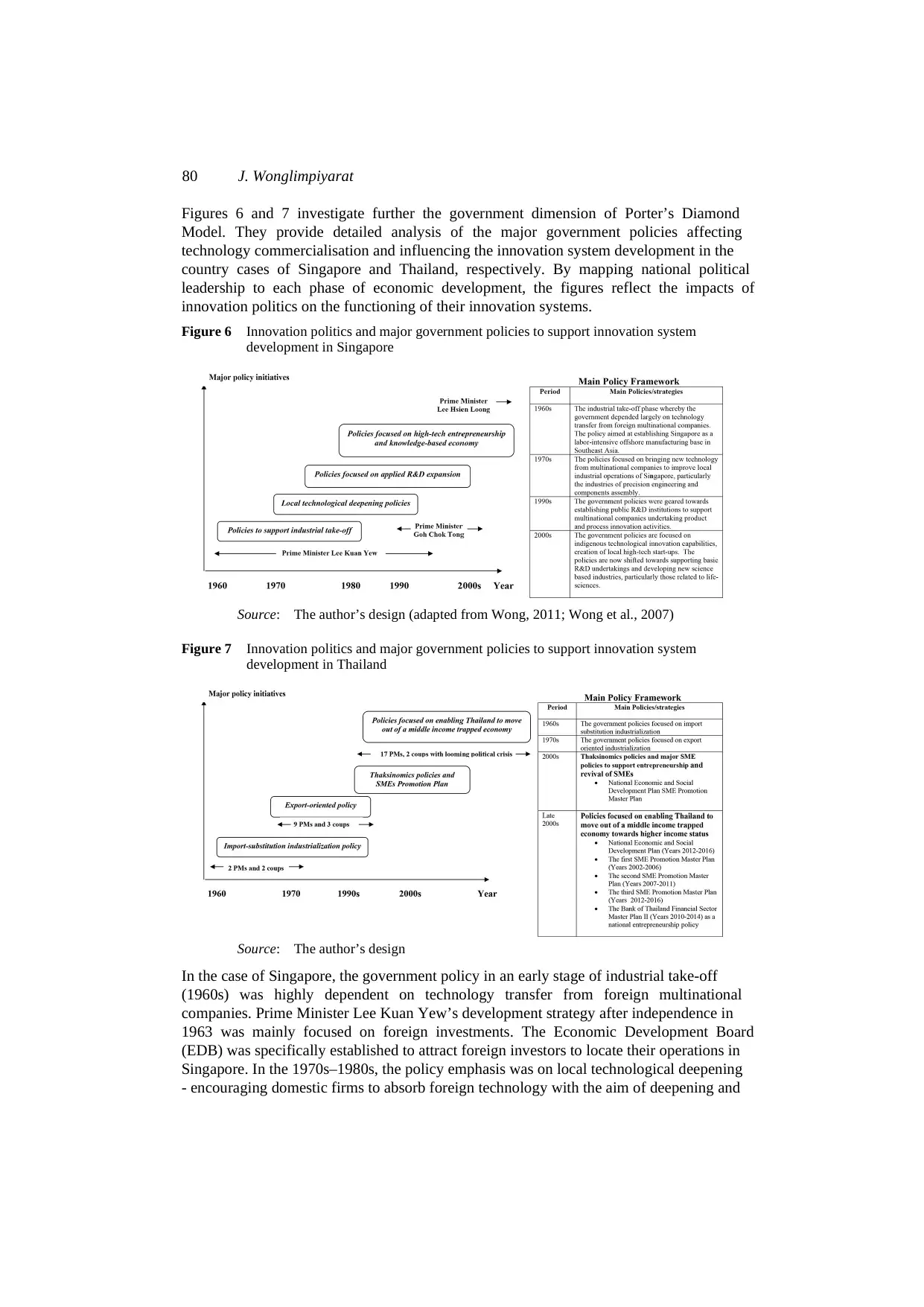
80 J. Wonglimpiyarat
Figures 6 and 7 investigate further the government dimension of Porter’s Diamond
Model. They provide detailed analysis of the major government policies affecting
technology commercialisation and influencing the innovation system development in the
country cases of Singapore and Thailand, respectively. By mapping national political
leadership to each phase of economic development, the figures reflect the impacts of
innovation politics on the functioning of their innovation systems.
Figure 6 Innovation politics and major government policies to support innovation system
development in Singapore
Source: The author’s design (adapted from Wong, 2011; Wong et al., 2007)
Figure 7 Innovation politics and major government policies to support innovation system
development in Thailand
Source: The author’s design
In the case of Singapore, the government policy in an early stage of industrial take-off
(1960s) was highly dependent on technology transfer from foreign multinational
companies. Prime Minister Lee Kuan Yew’s development strategy after independence in
1963 was mainly focused on foreign investments. The Economic Development Board
(EDB) was specifically established to attract foreign investors to locate their operations in
Singapore. In the 1970s–1980s, the policy emphasis was on local technological deepening
- encouraging domestic firms to absorb foreign technology with the aim of deepening and
Figures 6 and 7 investigate further the government dimension of Porter’s Diamond
Model. They provide detailed analysis of the major government policies affecting
technology commercialisation and influencing the innovation system development in the
country cases of Singapore and Thailand, respectively. By mapping national political
leadership to each phase of economic development, the figures reflect the impacts of
innovation politics on the functioning of their innovation systems.
Figure 6 Innovation politics and major government policies to support innovation system
development in Singapore
Source: The author’s design (adapted from Wong, 2011; Wong et al., 2007)
Figure 7 Innovation politics and major government policies to support innovation system
development in Thailand
Source: The author’s design
In the case of Singapore, the government policy in an early stage of industrial take-off
(1960s) was highly dependent on technology transfer from foreign multinational
companies. Prime Minister Lee Kuan Yew’s development strategy after independence in
1963 was mainly focused on foreign investments. The Economic Development Board
(EDB) was specifically established to attract foreign investors to locate their operations in
Singapore. In the 1970s–1980s, the policy emphasis was on local technological deepening
- encouraging domestic firms to absorb foreign technology with the aim of deepening and
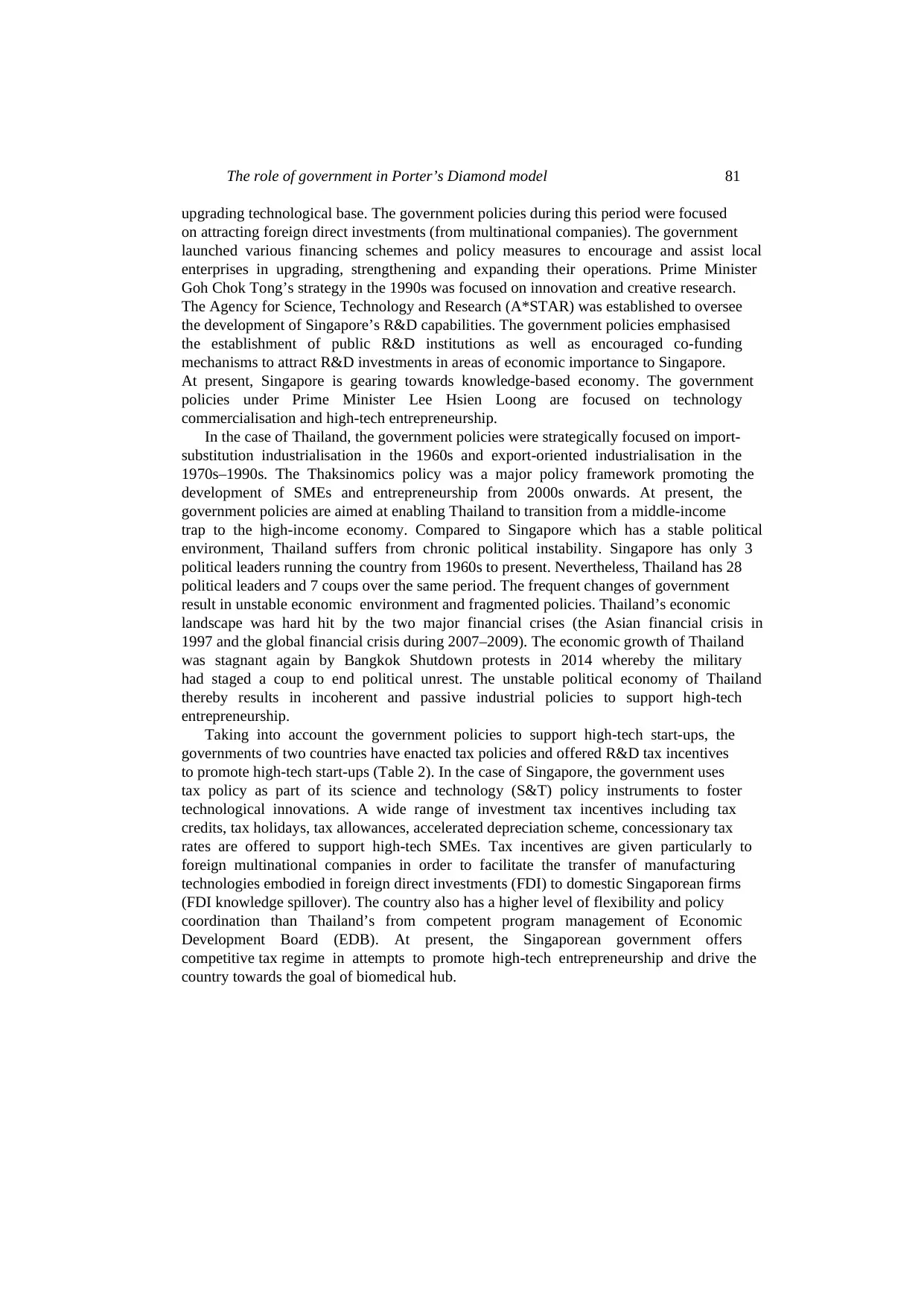
The role of government in Porter’s Diamond model 81
upgrading technological base. The government policies during this period were focused
on attracting foreign direct investments (from multinational companies). The government
launched various financing schemes and policy measures to encourage and assist local
enterprises in upgrading, strengthening and expanding their operations. Prime Minister
Goh Chok Tong’s strategy in the 1990s was focused on innovation and creative research.
The Agency for Science, Technology and Research (A*STAR) was established to oversee
the development of Singapore’s R&D capabilities. The government policies emphasised
the establishment of public R&D institutions as well as encouraged co-funding
mechanisms to attract R&D investments in areas of economic importance to Singapore.
At present, Singapore is gearing towards knowledge-based economy. The government
policies under Prime Minister Lee Hsien Loong are focused on technology
commercialisation and high-tech entrepreneurship.
In the case of Thailand, the government policies were strategically focused on import-
substitution industrialisation in the 1960s and export-oriented industrialisation in the
1970s–1990s. The Thaksinomics policy was a major policy framework promoting the
development of SMEs and entrepreneurship from 2000s onwards. At present, the
government policies are aimed at enabling Thailand to transition from a middle-income
trap to the high-income economy. Compared to Singapore which has a stable political
environment, Thailand suffers from chronic political instability. Singapore has only 3
political leaders running the country from 1960s to present. Nevertheless, Thailand has 28
political leaders and 7 coups over the same period. The frequent changes of government
result in unstable economic environment and fragmented policies. Thailand’s economic
landscape was hard hit by the two major financial crises (the Asian financial crisis in
1997 and the global financial crisis during 2007–2009). The economic growth of Thailand
was stagnant again by Bangkok Shutdown protests in 2014 whereby the military
had staged a coup to end political unrest. The unstable political economy of Thailand
thereby results in incoherent and passive industrial policies to support high-tech
entrepreneurship.
Taking into account the government policies to support high-tech start-ups, the
governments of two countries have enacted tax policies and offered R&D tax incentives
to promote high-tech start-ups (Table 2). In the case of Singapore, the government uses
tax policy as part of its science and technology (S&T) policy instruments to foster
technological innovations. A wide range of investment tax incentives including tax
credits, tax holidays, tax allowances, accelerated depreciation scheme, concessionary tax
rates are offered to support high-tech SMEs. Tax incentives are given particularly to
foreign multinational companies in order to facilitate the transfer of manufacturing
technologies embodied in foreign direct investments (FDI) to domestic Singaporean firms
(FDI knowledge spillover). The country also has a higher level of flexibility and policy
coordination than Thailand’s from competent program management of Economic
Development Board (EDB). At present, the Singaporean government offers
competitive tax regime in attempts to promote high-tech entrepreneurship and drive the
country towards the goal of biomedical hub.
upgrading technological base. The government policies during this period were focused
on attracting foreign direct investments (from multinational companies). The government
launched various financing schemes and policy measures to encourage and assist local
enterprises in upgrading, strengthening and expanding their operations. Prime Minister
Goh Chok Tong’s strategy in the 1990s was focused on innovation and creative research.
The Agency for Science, Technology and Research (A*STAR) was established to oversee
the development of Singapore’s R&D capabilities. The government policies emphasised
the establishment of public R&D institutions as well as encouraged co-funding
mechanisms to attract R&D investments in areas of economic importance to Singapore.
At present, Singapore is gearing towards knowledge-based economy. The government
policies under Prime Minister Lee Hsien Loong are focused on technology
commercialisation and high-tech entrepreneurship.
In the case of Thailand, the government policies were strategically focused on import-
substitution industrialisation in the 1960s and export-oriented industrialisation in the
1970s–1990s. The Thaksinomics policy was a major policy framework promoting the
development of SMEs and entrepreneurship from 2000s onwards. At present, the
government policies are aimed at enabling Thailand to transition from a middle-income
trap to the high-income economy. Compared to Singapore which has a stable political
environment, Thailand suffers from chronic political instability. Singapore has only 3
political leaders running the country from 1960s to present. Nevertheless, Thailand has 28
political leaders and 7 coups over the same period. The frequent changes of government
result in unstable economic environment and fragmented policies. Thailand’s economic
landscape was hard hit by the two major financial crises (the Asian financial crisis in
1997 and the global financial crisis during 2007–2009). The economic growth of Thailand
was stagnant again by Bangkok Shutdown protests in 2014 whereby the military
had staged a coup to end political unrest. The unstable political economy of Thailand
thereby results in incoherent and passive industrial policies to support high-tech
entrepreneurship.
Taking into account the government policies to support high-tech start-ups, the
governments of two countries have enacted tax policies and offered R&D tax incentives
to promote high-tech start-ups (Table 2). In the case of Singapore, the government uses
tax policy as part of its science and technology (S&T) policy instruments to foster
technological innovations. A wide range of investment tax incentives including tax
credits, tax holidays, tax allowances, accelerated depreciation scheme, concessionary tax
rates are offered to support high-tech SMEs. Tax incentives are given particularly to
foreign multinational companies in order to facilitate the transfer of manufacturing
technologies embodied in foreign direct investments (FDI) to domestic Singaporean firms
(FDI knowledge spillover). The country also has a higher level of flexibility and policy
coordination than Thailand’s from competent program management of Economic
Development Board (EDB). At present, the Singaporean government offers
competitive tax regime in attempts to promote high-tech entrepreneurship and drive the
country towards the goal of biomedical hub.
⊘ This is a preview!⊘
Do you want full access?
Subscribe today to unlock all pages.

Trusted by 1+ million students worldwide
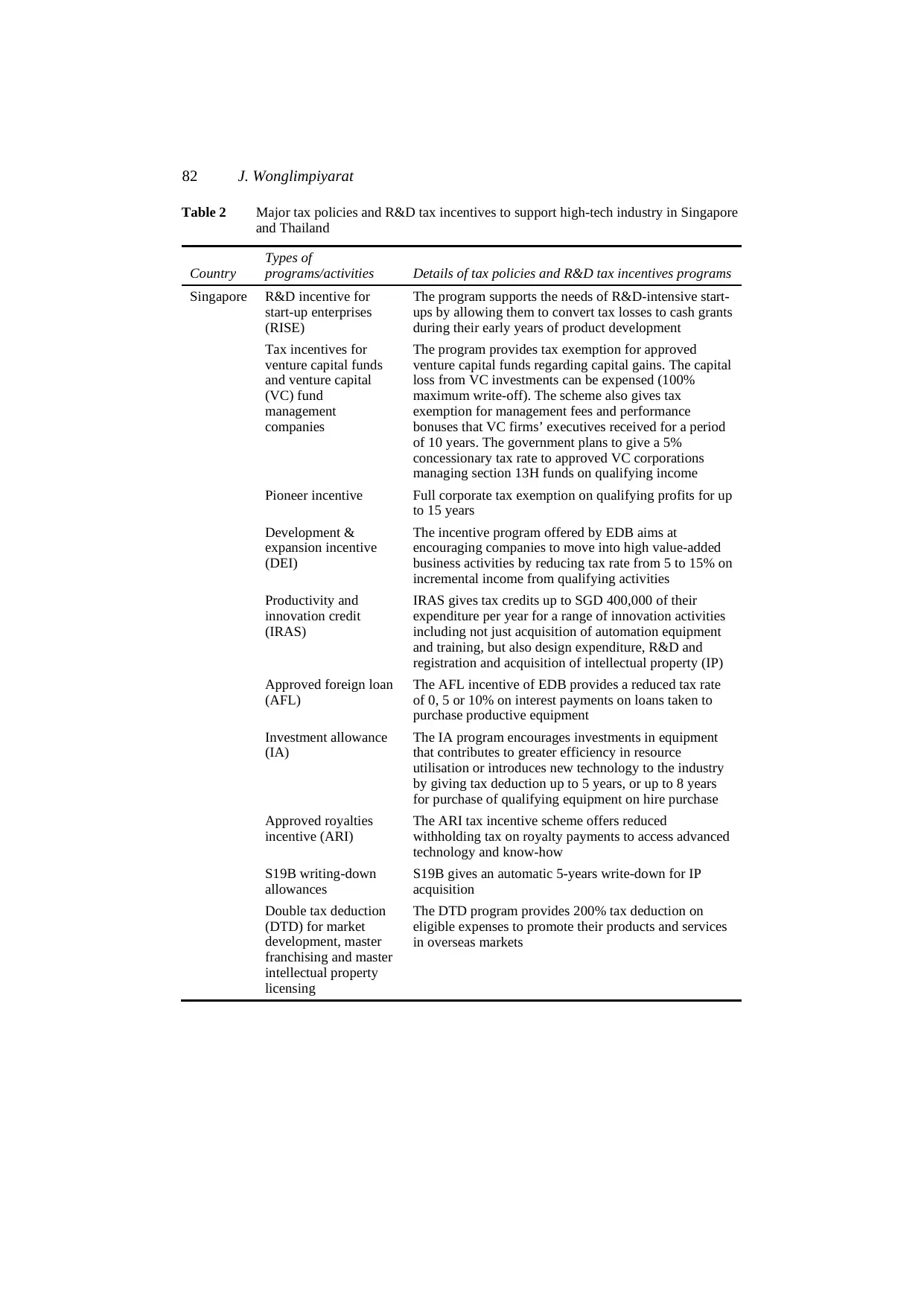
82 J. Wonglimpiyarat
Table 2 Major tax policies and R&D tax incentives to support high-tech industry in Singapore
and Thailand
Country
Types of
programs/activities Details of tax policies and R&D tax incentives programs
Singapore R&D incentive for
start-up enterprises
(RISE)
The program supports the needs of R&D-intensive start-
ups by allowing them to convert tax losses to cash grants
during their early years of product development
Tax incentives for
venture capital funds
and venture capital
(VC) fund
management
companies
The program provides tax exemption for approved
venture capital funds regarding capital gains. The capital
loss from VC investments can be expensed (100%
maximum write-off). The scheme also gives tax
exemption for management fees and performance
bonuses that VC firms’ executives received for a period
of 10 years. The government plans to give a 5%
concessionary tax rate to approved VC corporations
managing section 13H funds on qualifying income
Pioneer incentive Full corporate tax exemption on qualifying profits for up
to 15 years
Development &
expansion incentive
(DEI)
The incentive program offered by EDB aims at
encouraging companies to move into high value-added
business activities by reducing tax rate from 5 to 15% on
incremental income from qualifying activities
Productivity and
innovation credit
(IRAS)
IRAS gives tax credits up to SGD 400,000 of their
expenditure per year for a range of innovation activities
including not just acquisition of automation equipment
and training, but also design expenditure, R&D and
registration and acquisition of intellectual property (IP)
Approved foreign loan
(AFL)
The AFL incentive of EDB provides a reduced tax rate
of 0, 5 or 10% on interest payments on loans taken to
purchase productive equipment
Investment allowance
(IA)
The IA program encourages investments in equipment
that contributes to greater efficiency in resource
utilisation or introduces new technology to the industry
by giving tax deduction up to 5 years, or up to 8 years
for purchase of qualifying equipment on hire purchase
Approved royalties
incentive (ARI)
The ARI tax incentive scheme offers reduced
withholding tax on royalty payments to access advanced
technology and know-how
S19B writing-down
allowances
S19B gives an automatic 5-years write-down for IP
acquisition
Double tax deduction
(DTD) for market
development, master
franchising and master
intellectual property
licensing
The DTD program provides 200% tax deduction on
eligible expenses to promote their products and services
in overseas markets
Table 2 Major tax policies and R&D tax incentives to support high-tech industry in Singapore
and Thailand
Country
Types of
programs/activities Details of tax policies and R&D tax incentives programs
Singapore R&D incentive for
start-up enterprises
(RISE)
The program supports the needs of R&D-intensive start-
ups by allowing them to convert tax losses to cash grants
during their early years of product development
Tax incentives for
venture capital funds
and venture capital
(VC) fund
management
companies
The program provides tax exemption for approved
venture capital funds regarding capital gains. The capital
loss from VC investments can be expensed (100%
maximum write-off). The scheme also gives tax
exemption for management fees and performance
bonuses that VC firms’ executives received for a period
of 10 years. The government plans to give a 5%
concessionary tax rate to approved VC corporations
managing section 13H funds on qualifying income
Pioneer incentive Full corporate tax exemption on qualifying profits for up
to 15 years
Development &
expansion incentive
(DEI)
The incentive program offered by EDB aims at
encouraging companies to move into high value-added
business activities by reducing tax rate from 5 to 15% on
incremental income from qualifying activities
Productivity and
innovation credit
(IRAS)
IRAS gives tax credits up to SGD 400,000 of their
expenditure per year for a range of innovation activities
including not just acquisition of automation equipment
and training, but also design expenditure, R&D and
registration and acquisition of intellectual property (IP)
Approved foreign loan
(AFL)
The AFL incentive of EDB provides a reduced tax rate
of 0, 5 or 10% on interest payments on loans taken to
purchase productive equipment
Investment allowance
(IA)
The IA program encourages investments in equipment
that contributes to greater efficiency in resource
utilisation or introduces new technology to the industry
by giving tax deduction up to 5 years, or up to 8 years
for purchase of qualifying equipment on hire purchase
Approved royalties
incentive (ARI)
The ARI tax incentive scheme offers reduced
withholding tax on royalty payments to access advanced
technology and know-how
S19B writing-down
allowances
S19B gives an automatic 5-years write-down for IP
acquisition
Double tax deduction
(DTD) for market
development, master
franchising and master
intellectual property
licensing
The DTD program provides 200% tax deduction on
eligible expenses to promote their products and services
in overseas markets
Paraphrase This Document
Need a fresh take? Get an instant paraphrase of this document with our AI Paraphraser
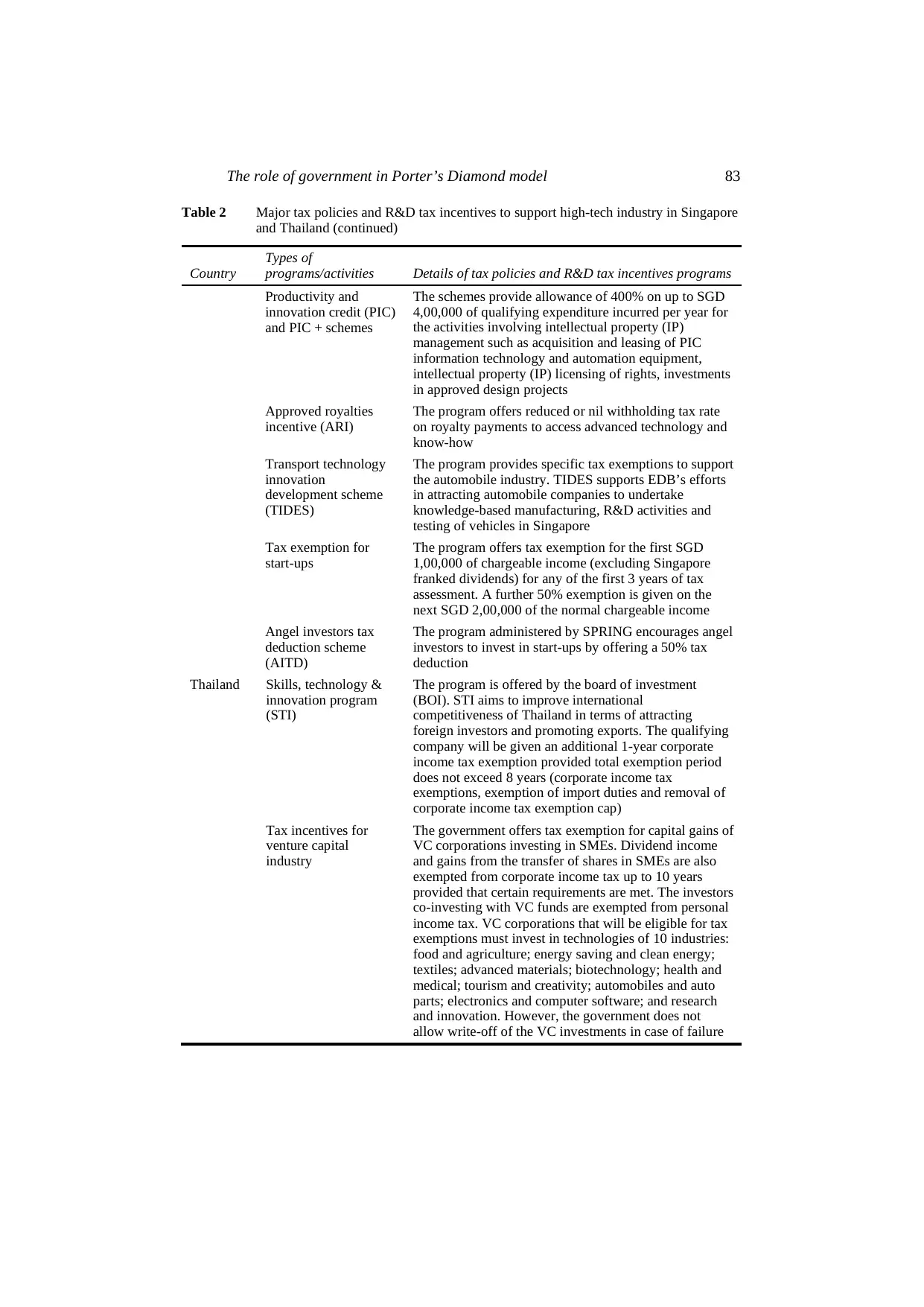
The role of government in Porter’s Diamond model 83
Table 2 Major tax policies and R&D tax incentives to support high-tech industry in Singapore
and Thailand (continued)
Country
Types of
programs/activities Details of tax policies and R&D tax incentives programs
Productivity and
innovation credit (PIC)
and PIC + schemes
The schemes provide allowance of 400% on up to SGD
4,00,000 of qualifying expenditure incurred per year for
the activities involving intellectual property (IP)
management such as acquisition and leasing of PIC
information technology and automation equipment,
intellectual property (IP) licensing of rights, investments
in approved design projects
Approved royalties
incentive (ARI)
The program offers reduced or nil withholding tax rate
on royalty payments to access advanced technology and
know-how
Transport technology
innovation
development scheme
(TIDES)
The program provides specific tax exemptions to support
the automobile industry. TIDES supports EDB’s efforts
in attracting automobile companies to undertake
knowledge-based manufacturing, R&D activities and
testing of vehicles in Singapore
Tax exemption for
start-ups
The program offers tax exemption for the first SGD
1,00,000 of chargeable income (excluding Singapore
franked dividends) for any of the first 3 years of tax
assessment. A further 50% exemption is given on the
next SGD 2,00,000 of the normal chargeable income
Angel investors tax
deduction scheme
(AITD)
The program administered by SPRING encourages angel
investors to invest in start-ups by offering a 50% tax
deduction
Thailand Skills, technology &
innovation program
(STI)
The program is offered by the board of investment
(BOI). STI aims to improve international
competitiveness of Thailand in terms of attracting
foreign investors and promoting exports. The qualifying
company will be given an additional 1-year corporate
income tax exemption provided total exemption period
does not exceed 8 years (corporate income tax
exemptions, exemption of import duties and removal of
corporate income tax exemption cap)
Tax incentives for
venture capital
industry
The government offers tax exemption for capital gains of
VC corporations investing in SMEs. Dividend income
and gains from the transfer of shares in SMEs are also
exempted from corporate income tax up to 10 years
provided that certain requirements are met. The investors
co-investing with VC funds are exempted from personal
income tax. VC corporations that will be eligible for tax
exemptions must invest in technologies of 10 industries:
food and agriculture; energy saving and clean energy;
textiles; advanced materials; biotechnology; health and
medical; tourism and creativity; automobiles and auto
parts; electronics and computer software; and research
and innovation. However, the government does not
allow write-off of the VC investments in case of failure
Table 2 Major tax policies and R&D tax incentives to support high-tech industry in Singapore
and Thailand (continued)
Country
Types of
programs/activities Details of tax policies and R&D tax incentives programs
Productivity and
innovation credit (PIC)
and PIC + schemes
The schemes provide allowance of 400% on up to SGD
4,00,000 of qualifying expenditure incurred per year for
the activities involving intellectual property (IP)
management such as acquisition and leasing of PIC
information technology and automation equipment,
intellectual property (IP) licensing of rights, investments
in approved design projects
Approved royalties
incentive (ARI)
The program offers reduced or nil withholding tax rate
on royalty payments to access advanced technology and
know-how
Transport technology
innovation
development scheme
(TIDES)
The program provides specific tax exemptions to support
the automobile industry. TIDES supports EDB’s efforts
in attracting automobile companies to undertake
knowledge-based manufacturing, R&D activities and
testing of vehicles in Singapore
Tax exemption for
start-ups
The program offers tax exemption for the first SGD
1,00,000 of chargeable income (excluding Singapore
franked dividends) for any of the first 3 years of tax
assessment. A further 50% exemption is given on the
next SGD 2,00,000 of the normal chargeable income
Angel investors tax
deduction scheme
(AITD)
The program administered by SPRING encourages angel
investors to invest in start-ups by offering a 50% tax
deduction
Thailand Skills, technology &
innovation program
(STI)
The program is offered by the board of investment
(BOI). STI aims to improve international
competitiveness of Thailand in terms of attracting
foreign investors and promoting exports. The qualifying
company will be given an additional 1-year corporate
income tax exemption provided total exemption period
does not exceed 8 years (corporate income tax
exemptions, exemption of import duties and removal of
corporate income tax exemption cap)
Tax incentives for
venture capital
industry
The government offers tax exemption for capital gains of
VC corporations investing in SMEs. Dividend income
and gains from the transfer of shares in SMEs are also
exempted from corporate income tax up to 10 years
provided that certain requirements are met. The investors
co-investing with VC funds are exempted from personal
income tax. VC corporations that will be eligible for tax
exemptions must invest in technologies of 10 industries:
food and agriculture; energy saving and clean energy;
textiles; advanced materials; biotechnology; health and
medical; tourism and creativity; automobiles and auto
parts; electronics and computer software; and research
and innovation. However, the government does not
allow write-off of the VC investments in case of failure
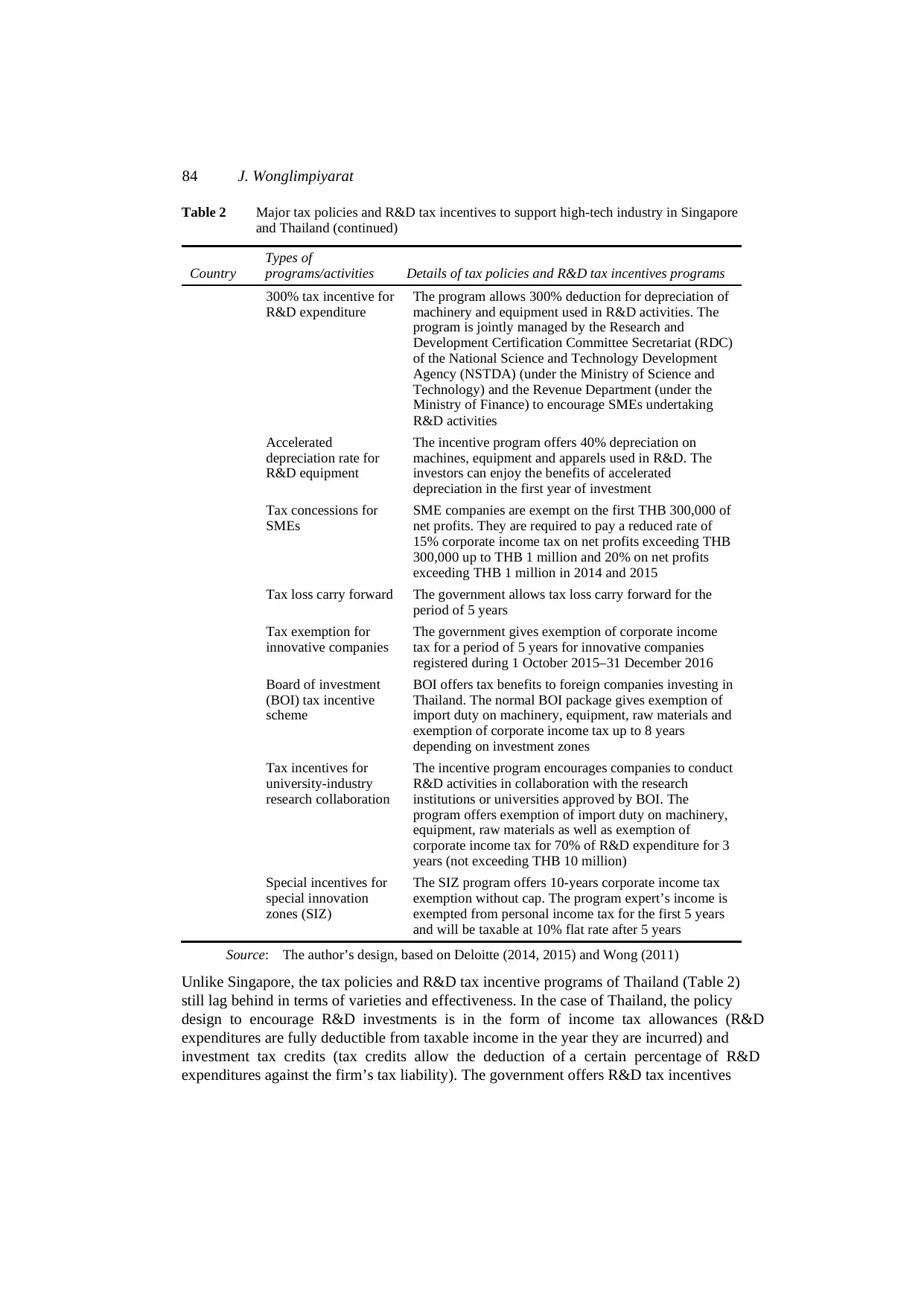
84 J. Wonglimpiyarat
Table 2 Major tax policies and R&D tax incentives to support high-tech industry in Singapore
and Thailand (continued)
Country
Types of
programs/activities Details of tax policies and R&D tax incentives programs
300% tax incentive for
R&D expenditure
The program allows 300% deduction for depreciation of
machinery and equipment used in R&D activities. The
program is jointly managed by the Research and
Development Certification Committee Secretariat (RDC)
of the National Science and Technology Development
Agency (NSTDA) (under the Ministry of Science and
Technology) and the Revenue Department (under the
Ministry of Finance) to encourage SMEs undertaking
R&D activities
Accelerated
depreciation rate for
R&D equipment
The incentive program offers 40% depreciation on
machines, equipment and apparels used in R&D. The
investors can enjoy the benefits of accelerated
depreciation in the first year of investment
Tax concessions for
SMEs
SME companies are exempt on the first THB 300,000 of
net profits. They are required to pay a reduced rate of
15% corporate income tax on net profits exceeding THB
300,000 up to THB 1 million and 20% on net profits
exceeding THB 1 million in 2014 and 2015
Tax loss carry forward The government allows tax loss carry forward for the
period of 5 years
Tax exemption for
innovative companies
The government gives exemption of corporate income
tax for a period of 5 years for innovative companies
registered during 1 October 2015–31 December 2016
Board of investment
(BOI) tax incentive
scheme
BOI offers tax benefits to foreign companies investing in
Thailand. The normal BOI package gives exemption of
import duty on machinery, equipment, raw materials and
exemption of corporate income tax up to 8 years
depending on investment zones
Tax incentives for
university-industry
research collaboration
The incentive program encourages companies to conduct
R&D activities in collaboration with the research
institutions or universities approved by BOI. The
program offers exemption of import duty on machinery,
equipment, raw materials as well as exemption of
corporate income tax for 70% of R&D expenditure for 3
years (not exceeding THB 10 million)
Special incentives for
special innovation
zones (SIZ)
The SIZ program offers 10-years corporate income tax
exemption without cap. The program expert’s income is
exempted from personal income tax for the first 5 years
and will be taxable at 10% flat rate after 5 years
Source: The author’s design, based on Deloitte (2014, 2015) and Wong (2011)
Unlike Singapore, the tax policies and R&D tax incentive programs of Thailand (Table 2)
still lag behind in terms of varieties and effectiveness. In the case of Thailand, the policy
design to encourage R&D investments is in the form of income tax allowances (R&D
expenditures are fully deductible from taxable income in the year they are incurred) and
investment tax credits (tax credits allow the deduction of a certain percentage of R&D
expenditures against the firm’s tax liability). The government offers R&D tax incentives
Table 2 Major tax policies and R&D tax incentives to support high-tech industry in Singapore
and Thailand (continued)
Country
Types of
programs/activities Details of tax policies and R&D tax incentives programs
300% tax incentive for
R&D expenditure
The program allows 300% deduction for depreciation of
machinery and equipment used in R&D activities. The
program is jointly managed by the Research and
Development Certification Committee Secretariat (RDC)
of the National Science and Technology Development
Agency (NSTDA) (under the Ministry of Science and
Technology) and the Revenue Department (under the
Ministry of Finance) to encourage SMEs undertaking
R&D activities
Accelerated
depreciation rate for
R&D equipment
The incentive program offers 40% depreciation on
machines, equipment and apparels used in R&D. The
investors can enjoy the benefits of accelerated
depreciation in the first year of investment
Tax concessions for
SMEs
SME companies are exempt on the first THB 300,000 of
net profits. They are required to pay a reduced rate of
15% corporate income tax on net profits exceeding THB
300,000 up to THB 1 million and 20% on net profits
exceeding THB 1 million in 2014 and 2015
Tax loss carry forward The government allows tax loss carry forward for the
period of 5 years
Tax exemption for
innovative companies
The government gives exemption of corporate income
tax for a period of 5 years for innovative companies
registered during 1 October 2015–31 December 2016
Board of investment
(BOI) tax incentive
scheme
BOI offers tax benefits to foreign companies investing in
Thailand. The normal BOI package gives exemption of
import duty on machinery, equipment, raw materials and
exemption of corporate income tax up to 8 years
depending on investment zones
Tax incentives for
university-industry
research collaboration
The incentive program encourages companies to conduct
R&D activities in collaboration with the research
institutions or universities approved by BOI. The
program offers exemption of import duty on machinery,
equipment, raw materials as well as exemption of
corporate income tax for 70% of R&D expenditure for 3
years (not exceeding THB 10 million)
Special incentives for
special innovation
zones (SIZ)
The SIZ program offers 10-years corporate income tax
exemption without cap. The program expert’s income is
exempted from personal income tax for the first 5 years
and will be taxable at 10% flat rate after 5 years
Source: The author’s design, based on Deloitte (2014, 2015) and Wong (2011)
Unlike Singapore, the tax policies and R&D tax incentive programs of Thailand (Table 2)
still lag behind in terms of varieties and effectiveness. In the case of Thailand, the policy
design to encourage R&D investments is in the form of income tax allowances (R&D
expenditures are fully deductible from taxable income in the year they are incurred) and
investment tax credits (tax credits allow the deduction of a certain percentage of R&D
expenditures against the firm’s tax liability). The government offers R&D tax incentives
⊘ This is a preview!⊘
Do you want full access?
Subscribe today to unlock all pages.

Trusted by 1+ million students worldwide
1 out of 16
Your All-in-One AI-Powered Toolkit for Academic Success.
+13062052269
info@desklib.com
Available 24*7 on WhatsApp / Email
![[object Object]](/_next/static/media/star-bottom.7253800d.svg)
Unlock your academic potential
Copyright © 2020–2025 A2Z Services. All Rights Reserved. Developed and managed by ZUCOL.
